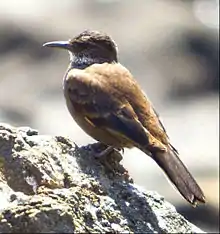Chilean seaside cinclodes
The Chilean seaside cinclodes (Cinclodes nigrofumosus) is a species of bird in the family Furnariidae. It is endemic to rocky shorelines in Chile. Some authorities include the Peruvian seaside cinclodes as a subspecies while others list it as a separate species. The ranges of the two do not overlap.[2]
| Chilean seaside cinclodes | |
|---|---|
 | |
| Scientific classification | |
| Kingdom: | Animalia |
| Phylum: | Chordata |
| Class: | Aves |
| Order: | Passeriformes |
| Family: | Furnariidae |
| Genus: | Cinclodes |
| Species: | C. nigrofumosus |
| Binomial name | |
| Cinclodes nigrofumosus (D'Orbigny & Lafresnaye, 1838) | |
| Synonyms | |
| |
Description
The Chilean seaside cinclodes grows to a length of about 21.5 cm (8.5 in). The upper parts are mainly a dark sooty brown, with a narrow whitish superciliary stripe and pale tips to the outer tail feathers. The wings have a rufous-buff bar that is chiefly visible in flight. The chin, throat and sides of the neck are white while the breast and belly are brown, streaked with white. The beak is charcoal grey and slightly curved and the rather short legs are dark grey.[2][3]
Distribution and habitat
This bird is endemic to Chile where it lives on the coast, typically on rocky shores with boulders and tidepools.[1] Its range extends from Arica to Valdivia.[3]
Ecology
Chilean seaside cinclodes bob their tail as they walk.[3] They have a loud trilling song, often uttered from the top of a boulder, and often flare their wings as they sing.[2] They forage singly or in pairs, searching along the foreshore for the small crustaceans and other invertebrates on which they feed, often hunting in surf-exposed places. Breeding takes place in August and September. The nest is built in a rock crevice or in a hole excavated in an earth bank and is formed out of grasses, with two to four white eggs being laid.[3]
Status
The Chilean seaside cinclodes has a very wide range and is described as common. The population trend seems to be steady, and the total population is large. No particular threats have been identified and the International Union for Conservation of Nature (IUCN) has assessed the bird's conservation status as being of "least concern".[1]
References
| Wikimedia Commons has media related to Cinclodes nigrofumosus. |
| Wikispecies has information related to Cinclodes nigrofumosus. |
- BirdLife International (2016). "Cinclodes nigrofumosus". IUCN Red List of Threatened Species. 2016: e.T22702107A93860325. Retrieved 23 June 2020.
- Ridgely, Robert S.; Tudor, Guy (2009). Field Guide to the Songbirds of South America: The Passerines. University of Texas Press. p. 71. ISBN 978-0-292-71748-0.
- Chester, Sharon (2010). A Wildlife Guide to Chile: Continental Chile, Chilean Antarctica, Easter Island, Juan Fernández Archipelago. Princeton University Press. p. 248. ISBN 1-4008-3150-4.
